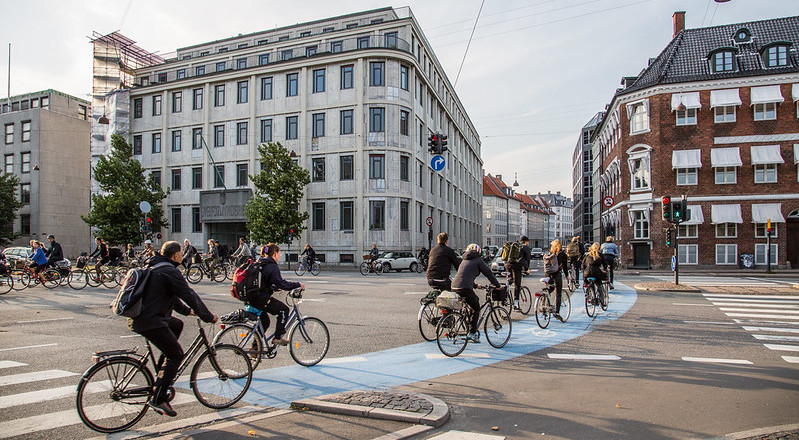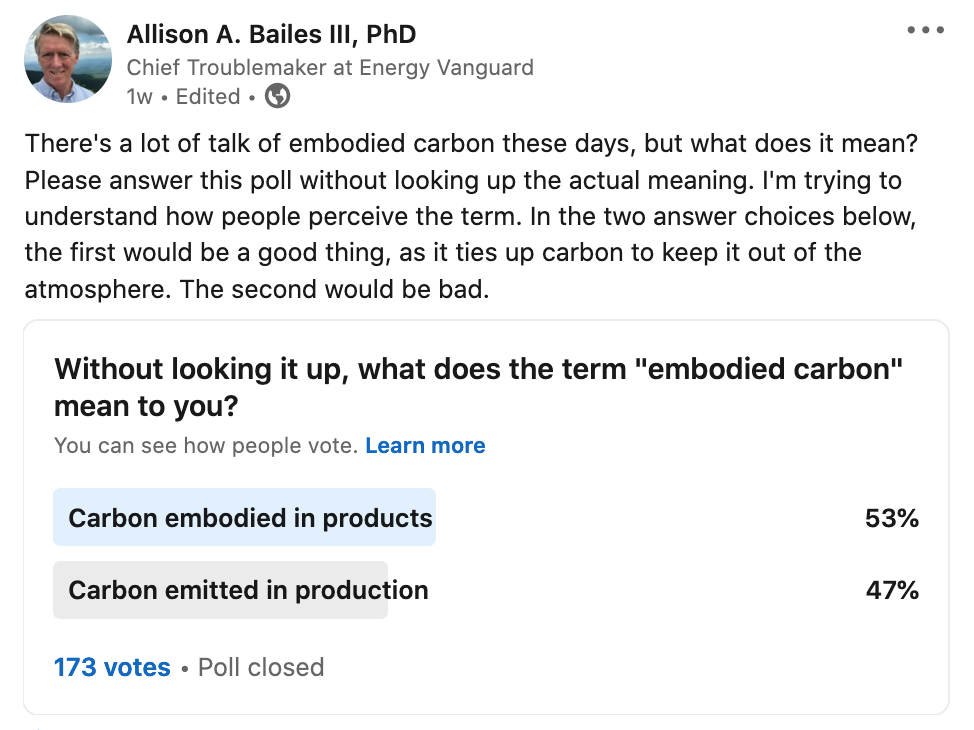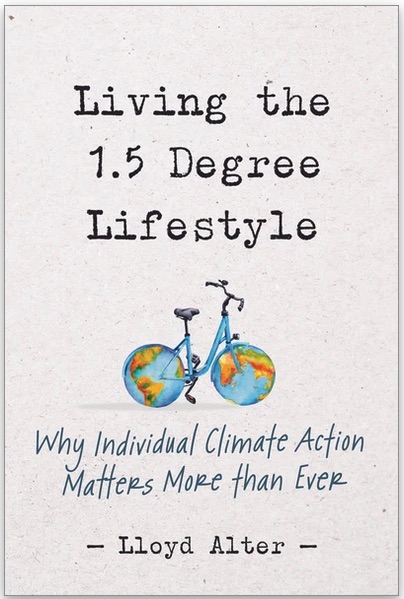Lloyd Alter Is Living the 1.5 Degree Lifestyle

Lloyd Alter, architect and prolific blogger at Treehugger, has a new book. Titled Living the 1.5 Degree Lifestyle,* the book is an exploration of what it takes to live within a pretty strict carbon budget. That means tracking the carbon emissions impact of everything he does: what he eats, how he travels, what he wears, the electronic devices he buys, and more.
But it was his subtitle that really grabbed my attention: Why Individual Climate Action Matters More Than Ever. For the past few years, I’ve been with the crowd that believes individual action can’t solve this problem. Without big shifts in new technology and government policy, individual action seems to be ineffective. So, I began reading, hoping that Alter would win me over.
I’m going to cover some of the important points in the book, but you’ll need to get a copy and read it yourself if you want to understand all that he has to say…which is a considerable amount, especially for a brief 142 pages.
The premise
Whether you believe it or not, you know the story line by now. The Industrial Revolution began an unintentional experiment to see if we humans could change the climate on Earth. Before the Industrial Revolution, the average atmospheric carbon dioxide (CO2) level was 280 parts per million (ppm). Two centuries later, it was up to 319 ppm when I was born. Yesterday, the CO2 level at Mauna Loa was 416 ppm, 49% higher than it was in 1750 and 30% higher just in my lifetime.
And, as Svante Arrhenius predicted in the 19th century, the Earth is warming. There’s tons of evidence that increasing the concentration of CO2 in the atmosphere raises the global average temperature. We know we need to reduce the emissions of carbon dioxide and other greenhouse gases, collectively referred to as CO2e (the e stands for equivalent). The 2015 Paris Accord is where the 1.5 degree number came from, as the participating nations agreed to keep the global temperature from rising more than 1.5° C above what it was at the dawn of the Industrial Revolution.
That limit to temperature increase correlates with specific targets for carbon emissions. The goal is to get total carbon dioxide emissions down to 2.5 tonnes (1,000 kilograms) per year per person by 2030 and down to 1 tonne per year per person by 2050. Alter chose the easier 2030 target for his experiment in living the 1.5 degree lifestyle. That put him on a diet of about 7 kg of CO2e per day. To track his personal CO2e emissions, he created a spreadsheet and recorded everything with a carbon impact.
The 2 kinds of carbon emissions
But first, we can’t jump into carbon tracking without distinguishing between the two kinds of carbon emissions.
Operational carbon emissions – the greenhouse gases (CO2e) emitted as the result of operating a building, vehicle, or device.
Embodied carbon emissions – the CO2e emitted as a result of making those buildings, vehicles, or devices.
When you burn fuel for heat at your house, for example, the exhaust gases put CO2 into the air right there. The electricity you use is usually generated somewhere else, but it still results in greenhouse gas emissions. Those are both operational carbon. Embodied carbon emissions are the greenhouse gases emitted during the mining, transport, and manufacturing of all the stuff that goes into you house: building materials, furniture, food…everything. Because of the structure of our economy, almost everything we do has a carbon impact, operational and embodied.
The embodied carbon problem
But there’s a problem with the term “embodied carbon emissions.” Often, the word “emissions” is left off. Do a search and you’ll see few instances of the full three-word term. Everyone wants to talk about embodied carbon. And because a lot of people don’t know much about it, they assume embodied carbon is a good thing.
Last week I posted a poll on LinkedIn and Twitter asking what people thought embodied carbon means. Here are the LinkedIn results:

At 42 and 58 percent, the Twitter results weren’t much better. Clearly, a lot of people seem to believe embodied carbon is good because it’s carbon tied up in here on the ground instead of trapping heat in the atmosphere. Maybe they’re confusing it with sequestered carbon.
Also, the full three-word term contradicts itself. Is the carbon embodied? Or is it emitted? It’s hard to imagine it could be both.
I mention this here because Alter has come up with a much better term: upfront carbon emissions. It would be hard to think that’s a good thing. He’s gotten some traction with adoption of the term already, and I think everyone should start using it and drop the confusing “embodied carbon” immediately.
A few tidbits
Alter’s book is packed with great information and pithy quotes. Here are a few of the things I found notable, some of which were new to me.
![Carbon emissions shown as Scope 1, Scope 2, or Scope 3 [Credit: US EPA]](https://www.energyvanguard.com/wp-content/uploads/2021/12/carbon-emissions-scope-1-2-3-800.jpeg)
- Carbon emissions are counted in one of three categories: Scope 1, Scope 2, and Scope 3, as shown in the EPA diagram above. When companies claim they’re carbon neutral, ask if they’re including Scope 3 emissions.
- Energy and money are the same thing. This comes from Vaclav Smil, the great writer of weighty tomes on energy whom I learned about in 2005 in my peak oil days. It means simply that having more money gives you the power to control more energy.
- Alter believes the Jevons Paradox is real. I found this comforting because some people in this field don’t believe it. Also known as the rebound effect, this paradox says that efficiency gains lead to greater consumption. Read more about it on the Interwebs or in Alter’s book.
- In discussing the CO2e of food, Alter goes into detail about the “cold chain,” the system of refrigerated transportation that uses a lot of energy.
- Net zero energy is not the same thing as net zero carbon. Right now, carbon—especially upfront carbon—is more important.
- The “15-minute city” is a name for being able to walk or bike within 15 minutes to most of the things you do. It makes living the 1.5 degree lifestyle easier, and Alter lives in such a community himself.
- e-bikes are the next big thing.
- Alter talked about being a cottager in the summer and buying Norwegian wood in a bag…and missed the opportunity to make a Beatles joke.
- A paraphrase of something from Robert Ayres: “The purpose of the economy is to turn energy into stuff.”
- Beer Can Appreciation Day is a fake holiday. “I yell at my own kids about buying beer in cans,” Alter wrote, lamenting the loss of returnable bottles and the increased carbon emissions of disposable containers.
- Operational emissions dominate in housing and cars, but upfront carbon is the biggie with electronic devices…
- But, “There is a giant pile of carbon behind every minute of our screen time.” The Internet and the entertainment industries are huge emitters.
My take
Chapter 4 is the most important chapter in Living the 1.5 Degree Lifestyle. It’s titled Energy, Efficiency, and Sufficiency, and he gets into some deep discussions of energy, the economy, and growth. That’s where he quotes Vaclav Smil and brings up a book about something called “degrowth.” It’s the stuff we really need to grapple with as we navigate the climate crisis. I was hoping he would mention the work of physicist Albert Bartlett, which would have fit in well here, but he didn’t.
Alter’s diligence in researching the CO2e associated with all his activities is impressive. He shows parts of his spreadsheet throughout the book and discusses where he succeeded, where he failed, the lessons he learned, and the things that surprised him. He’s done a great service by digging into this.
So, did Alter win me over? Do I now believe that individual action matters more than ever? Here’s my problem with this claim: It just seems to me that if it’s going to take a concerted effort by a significant portion of the population to avert climate catastrophe, we’re already screwed. I can’t see it happening.
I know that sounds like what Michael Mann calls “doomism.” But while reading the book on the plane to Seattle (hmmmm), I looked at what the people around me were doing in airports, restaurants, and stores. I don’t see an appetite for this kind of change. Also, because we can’t even have a real debate about climate change in the US, many people here aren’t even aware of the problem, much less the kinds of solutions that Alter discusses.
But here’s what happened. After reading the book, I found that my thinking had changed. My MacBook Pro, for example, is six years old now, and I’d been thinking of getting a new one next year. Now I’m thinking I’ll try to squeeze as much life out of it as I can before replacing it; maybe even just replacing the battery, which has a cycle count of 1,996 right now and is giving me the “Service Recommended” warning. And that kind of thinking has spread to a lot of my decisions.
Living the 1.5 Degree Lifestyle is an important book. It’s well documented, easy to read, and full of great information. Alter has really done his homework, literally! I recommend it highly.

Allison A. Bailes III, PhD is a speaker, writer, building science consultant, and the founder of Energy Vanguard in Decatur, Georgia. He has a doctorate in physics and writes the Energy Vanguard Blog. He is also writing a book on building science. You can follow him on Twitter at @EnergyVanguard.
Related Articles
The Science of Global Warming Is Older Than Quantum Mechanics
Calculating the Global Warming Impact of Insulation
Climate Change Is Just a Theory
* This is an Amazon Associate link. You pay the same price you would pay normally, but Energy Vanguard may make a small commission if you buy after using the link.
Photo of bicycle commuters by Holbergsgade Cyclists from flickr.com, used under a Creative Commons license.
NOTE: Comments are moderated. Your comment will not appear below until approved.
This Post Has 17 Comments
Comments are closed.

Great post, Allison. I’ll get the book.
Thanks, John! You’ll enjoy it, I’m sure.
This is a very thought provoking review. Definitely interested in checking out the book. Could always use more encouragement to really get the full useful life out of items I buy, or buy less, or bike and walk more to things in a 15 minute radius of my home.
Thanks, Alyce! This book’ll do that for you.
Thanks for posting this Allison – more people need to hear it. I am ordering the book today for pick up at a local bookstore rather than a delivery. I am guessing that consolidated shipments to a bookstore from a publisher have a smaller per book carbon footprint – but then it all goes downhill if you drive your ICE vehicle to go get it (see how you start to think about this?, and that is just after reading your review. I have 3 x 10 plus year old Macs, none of which can be upgraded to the latest operating system. I would love to get Tim Cook over for a coffee and a chat about that.
Roy, yeah, obsolescence of hardware has doomed a lot of equipment that still had useful life left. I had to upgrade from the iPhone 6 to the 8 because the battery crapped out after an update to the latest iOS.
This obsolescence is a big – big deal!
I have a 15 year old Mac Pro with dual Xeon processors that is an absolute BEAST at photo processing – still kills it over my newer machines. Last year the video card crapped out and lo and behold – said video card is no longer available (for an original price $4,000.00 computer). Fortunately, I have a talented Mac tech locally who found someone to REPAIR the video card. That ain’t likely to happen again.
But then there was my top of the line 36” LG refrigerator with in-door ice and yadda, yadda, yadda (I had to rebuild my kitchen cabinets to fit the bad boy in). Three years later after the second compressor failure and zero response from LG – into the landfill it went. I took it to the metal recycle depot and they refused it. Landfill – a 3 year old top of the line refrigerator.
Something has to give here.
I see this planned obsolescence as a real problem too. I have a bunch of old cell phones and computers at home that are mechanically sound but no longer supported by the manufacturer since they obviously wanted to sell me new ones. I also have a bunch of other equipment that quit working (treadmill, TV’s, etc.) that no one wants to repair or are too cheap to repair, but that also shouldn’t be put in the landfill. No one seems to want to recycle them either. Goodwill, Habitat ReStores, etc. don’t want this stuff either. As much as I hate to say it, perhaps we should require deposits on this type of equipment at the time of purchase that are redeemable at repair or recycling centers at the end of their useful life. Obviously the deposit amounts would have to be high enough to justify these centers and to get people to return the old equipment there.
‘
I agree with the comments about returnable containers. I am old enough to remember when beer and pop (soda for you Easterners) only came in returnable bottles. Then disposable cans and bottles were also put on the market for convenience, but they cost more, so there was a price for this convenience. The environmentalists wanted these disposable containers to be recycled, so they pushed for deposits on these containers. I was certain that these deposits would spell the end of disposable beverage containers. But the opposite happened:
returnable (refillable) containers disappeared from the market. Was this good for the environment? No! Was it good for the consumer? I don’t think so.
So if you think recycling is good in this case, let me ask you which option you think uses less energy: washing a bottle or melting it and reforming it? One should also remember that returnable bottles went back to the beverage company in the same truck that delivered the filled bottles. The disposable cans and bottles are delivered to a recycling center in a different truck. There just isn’t any upside to recycling something that could be reused instead, other than convenience.
RoyC, you might be interested in what Lloyd has to say about recycling. He’s called it “a fraud, a sham, a scam perpetrated by big business on the citizens and municipalities of America.” He also pointed out something in the book that I wasn’t aware of. Disposable bottles and cans led to much greater energy use because Coca Cola just shipped the syrup to distributors because handling all the returnable bottles would cost too much. With disposable containers, they could add the water themselves and make more money. And that meant shipping all that water all over the place.
Allison, I am not sure I understand the comments about syrup. As far as I know, Coke was shipping syrup to regional bottling plants before and after the use of disposable bottles and cans. As far as I now the water has always been obtained locally at these plants. So I don’t think the shift from refillable to recyclable containers had anything to do with that. I guess I will have to buy the book to get into the details, but I generally don’t listen much to architects 😉
Hey Allison, on that last point, there is a website called iFixIt.com, which sells some replacement parts for computers, tools to help remove and install replacements, and instructional rundowns. I have also recently found out they have an activist arm, lobbying federal and state governments to prevent companies from restricting access to repair tool and instructions and claiming a voided warranty after a user repair.
Oh and there’s also Otherworld Computing (aka Macsales.com) which sells replacement parts and upgrades, and MacOfAllTrades which sells used computers. I’ve been an Apple-head since my teen years, and only a couple times in my adult life have I bought a new machine.
Thanks, Avery. I’ve bought hard drives and memory from Otherworld for this and my previous Mac.
Nice review, Allison. The lengthy book excerpt is a worthy read.
But Alter’s book is just one component of the many steps needed to reduce the potential impact of the Anthropocene extinction. I hope Alter builds on Al Bartlett’s points about the crux of the problem (exponents!) in a sequel edition.
Switching a global growth-oriented economy to a sustainable and resilient economy is not likely to happen without disruption and pain. It will be interesting to see how capitalism might reinvent economic growth from a “make more” economy to a “make better” economy.
So, what’s the CO2e impact of buying the paperback vs. a digital version? Is there a lower CO2e if I buy from New Society Publishers vs Amazon?
I have had similar issues with new equipment, and it frustrates me to see stuff built so poorly nowadays. I have been told, though, that part of that reasoning is because companies that built their stuff too well went out of business when the market saturated and they weren’t selling any more of that item.
I like to see stuff get the most possible life out of it, and that leads me to look for used items as well that might be built better.
Excellent review of what sounds like an excellent book. Thank you, Allison–it’s next on my list!